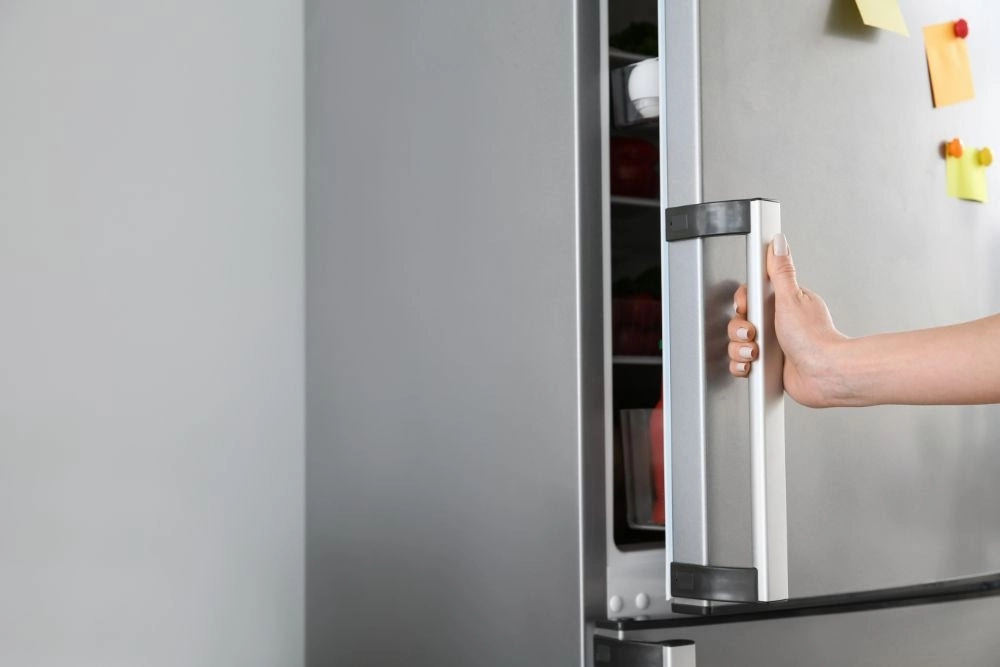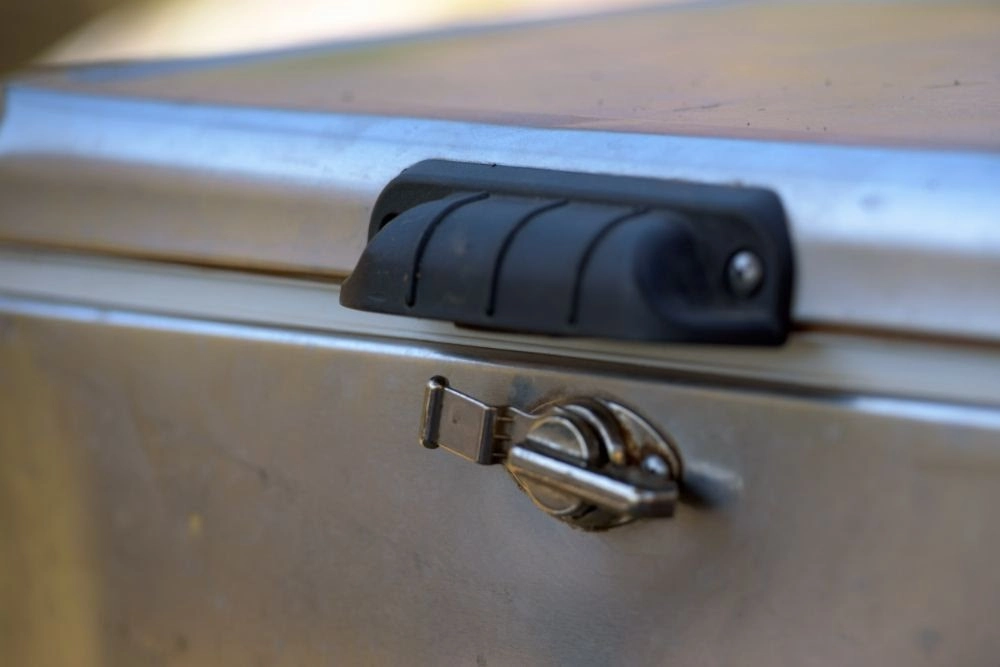A freezer door lock is an essential component that helps ensure the safety and efficiency of your freezer. It's designed to keep the door shut tightly, preventing cold air from escaping and warm air from entering. This way, you can maintain optimal temperature levels for food storage and prevent frost buildup.
The other purpose of an appliance lock like a freezer lock or fridge lock is to prevent unauthorized people from opening the appliance. Usually this is to keep children out of dangerous situations. A child trapped in a freezer can be deadly.
Most freezer door locks consist of a locking mechanism and a latch or hook. The latch connects with the lock when the door is closed, securing it in place.
Some locks come with keys, while others use a combination or electronic code for unlocking. These can be especially useful in commercial settings or for families with small children.
Over time, your freezer door lock may wear down or become damaged, requiring replacement. In such cases, it's crucial to address the issue promptly to maintain the efficiency and safety of your freezer.
If you want to keep your food safe in your freezer, a good lock is crucial. Let's explore some popular brand options.
GE offers a range of freezer door locks that are easy to install and use. Their locks are durable and made to fit most doors.
Some GE models also include an adjustable strike plate. This helps keep the door aligned, even with changes in temperature.
Electrolux provides high-quality door locks for its freezer line. They focus on both safety and ease of use.
Their locks are designed for a tight seal, which means your freezer stays efficient and your food stays fresh.
Frigidaire freezer locks include extra replacement keys to make sure you always have access. Their locks fit most freezer doors and are easy to replace if needed.
You can find Frigidaire freezer locks at retailers like A-1 Appliance for around $6.15 for a key.
Let's discuss the different lock and key components for your freezer door:
The latch assembly is a crucial part of your freezer door lock, as it helps secure the door in place. It consists of a latch and a catch. When you close your freezer door, the latch slides into the catch, keeping the door locked.
You need to take good care of this component, ensuring it remains clean, functional, and well-lubricated. If something seems off, don't hesitate to check and replace it, as a malfunctioning latch assembly can compromise your freezer's efficiency.
When replacing any lock and key components, it's essential to know the correct part numbers. These are unique identifiers assigned by the manufacturer to each part of your freezer.
Using the wrong parts can lead to malfunctions or damage to your freezer door. You can usually find part numbers on the manufacturer's website, in the user manual, or through a customer support representative.
Your freezer door lock system depends on a well-maintained door frame. The door frame is where the latch assembly connects, ensuring the door stays securely closed.
Keep the door frame free of dirt and debris, and check for signs of wear or damage. If you notice any damage, contact your manufacturer for proper repair, as a damaged door frame can affect your freezer's performance and energy efficiency.
Remember, maintaining a functional lock and key system for your freezer door is important for both safety and efficiency. Regularly inspecting and maintaining these components will help keep your freezer operating at peak performance.
Dealing with freezer door lock issues can be frustrating.
In this section, we will cover the most common door lock problems and their possible causes. We'll look at damaged locks, loose doors, and broken keys.
Over time, your freezer lock may become damaged or worn. This can lead to difficulty locking or unlocking the door.
Causes of a damaged lock may include rust, dirt buildup, or simple wear and tear. To fix this issue, you may need to clean or replace the lock. If you're unsure, contact a professional for help.
A loose freezer door can cause problems with the lock. This is often due to the freezer not being level. If you notice that your freezer door is not sealing properly or is easily coming undone, it's time to adjust the level.
You can do this by leveling the freezer from side to side and front to back. A level door will help prevent lock problems and ensure your freezer maintains a proper temperature.

A loose freezer door needs immediate attention!
Another common issue is a broken key. If your key snaps off in the lock, it can be hard to open your freezer.
To fix this, you'll need a pair of needle-nose pliers to remove the broken key. If you're unable to remove it or if there is extensive damage to the lock, you may need to call a professional to replace the lock or find another solution.
By addressing these common freezer lock problems, you can keep your freezer functioning properly and ensure the safety of your stored food.
Let's dive into some common freezer door lock troubleshooting and repair methods to help you resolve any issues efficiently.
When your freezer door gets stuck or won't unlock, try these techniques:
Check out this incredibly helpful and easy tutorial for fixing a refrigerator door seal!
If the unlocking techniques fail, you may need to examine and replace parts of the lock by following these:
Finally, if you're still experiencing issues with your freezer door lock after trying these troubleshooting tips, it's time to call in the pros.
Get a professional locksmith to assess the problem, diagnose the issue, and provide the necessary repairs. This way, you can be sure your appliance is in good hands and your problem will be resolved efficiently.
Keeping your freezer lock in good shape is essential for easy access and optimal efficiency.
It's important to clean your freezer lock regularly. Dirt and debris can accumulate over time, hindering the lock's function.
To clean the lock, use a soft cloth to wipe away any visible dirt. For hard-to-reach spots, a gentle brush can help.

Clean and lubricate your freezer lock for smooth functioning!
Lubricating your freezer lock is crucial to ensuring smooth operation. Apply a small amount of a suitable lubricant, like WD-40, to the keyhole and moving parts.
This not only helps prevent freezing but also reduces wear and tear, ultimately prolonging the lock's life.
Moisture and humidity can cause freezer lock issues. To avoid this, avoid putting hot foods into the freezer, as this increases humidity.
You should also regularly check and replace the door seal if necessary to prevent cold air from escaping and warm air from entering.
By following these simple and cost-effective tips, you can keep your freezer lock in great working condition for years to come.
When your door lock is frozen, you can use a hairdryer to melt the ice. Aim the warm air at the lock for a few seconds until you see the ice start to melt.
Keep the heat on the lock for a bit longer to make sure the ice inside has also melted. Then test your key and unlock the door.
For frozen interior locks, the best fix is to act before the cold turns your lock into ice. Apply a rust inhibitor, like WD-40, to keep water out and prevent freezing.
If needed, dip your key in petroleum jelly and turn the lock back and forth a few times. This can help keep the lock safe from the cold.
If your interior lock is already frozen, you can also try warming your key before using it. Some ways to heat your key. One way to accomplish this is by soaking it in hot liquid, like water or coffee.
Be careful not to burn yourself or damage the key while heating it. Make sure the key is dry and warm before you insert it into the lock. This can help melt the ice inside the lock and get your door open.
